An Aspect-Based Emotion Analysis Approach on Wildfire-Related Geo-Social Media Data—A Case Study of the 2020 California Wildfires
Abstract
1. Introduction
- RQ: Can the application of Aspect-based Emotion Analysis to geo-social media data offer actionable insights for disaster response by revealing distinct spatio-temporal patterns for specific emotions and emotion-targets?
2. Related Works
3. Methodology
3.1. Use Case
3.2. Data
3.3. ABEA Inferences
3.4. Spatio-Temporal Analysis
4. Results
4.1. Regional Emotion Ratio Changes
4.2. Regional Aspect Term Time Series
4.3. Emotions and Aspect Terms at the Local Level
5. Discussion
5.1. Limitations of Methodology
5.2. Wildfire Subsets
5.3. Validation Through Wildfire Data
5.4. Modifiable Area Unit Problem
6. Conclusions
Author Contributions
Funding
Data Availability Statement
Conflicts of Interest
Abbreviations
| ABEA | Aspect-based Emotion Analysis. |
| ABSA | Aspect-based Sentiment Analysis. |
| AEC | Aspect Emotion Classification. |
| API | Application Programming Interface. |
| ATE | Aspect Term Extraction. |
| BERT | Bidirectional Encoder Representations from Transformers. |
| MAUP | Modifiable Areal Unit Problem. |
| SA | Sentiment Analysis. |
References
- Imran, M.; Castillo, C.; Diaz, F.; Vieweg, S. Processing Social Media Messages in Mass Emergency: A Survey. ACM Comput. Surv. 2015, 47, 67. [Google Scholar] [CrossRef]
- Acikara, T.; Xia, B.; Yigitcanlar, T.; Hon, C. Contribution of Social Media Analytics to Disaster Response Effectiveness: A Systematic Review of the Literature. Sustainability 2023, 15, 8860. [Google Scholar] [CrossRef]
- Sun, J.; Qi, W.; Huang, Y.; Xu, C.; Yang, W. Facing the Wildfire Spread Risk Challenge: Where Are We Now and Where Are We Going? Fire 2023, 6, 228. [Google Scholar] [CrossRef]
- Neppalli, V.; Caragea, C.; Squicciarini, A.; Tapia, A.; Stehle, S. Sentiment analysis during Hurricane Sandy in emergency response. Int. J. Disaster Risk Reduct. 2017, 21, 213–222. [Google Scholar] [CrossRef]
- Liu, H.; Chatterjee, I.; Zhou, M.; Lu, X.S.; Abusorrah, A. Aspect-Based Sentiment Analysis: A Survey of Deep Learning Methods. IEEE Trans. Comput. Soc. Syst. 2020, 7, 1358–1375. [Google Scholar] [CrossRef]
- Pontiki, M.; Galanis, D.; Papageorgiou, H.; Androutsopoulos, I.; Manandhar, S.; Al-Smadi, M.; Al-Ayyoub, M.; Zhao, Y.; Qin, B.; De Clercq, O.; et al. SemEval-2016 Task 5: Aspect Based Sentiment Analysis. In Proceedings of the 10th International Workshop on Semantic Evaluation (SemEval-2016), San Diego, CA, USA, 16–17 June 2016; pp. 19–30. [Google Scholar] [CrossRef]
- Balahur, A.; Mihalcea, R.; Montoyo, A. Computational approaches to subjectivity and sentiment analysis: Present and envisaged methods and applications. Comput. Speech Lang. 2014, 28, 1–6. [Google Scholar] [CrossRef]
- Kryvasheyeu, Y.; Chen, H.; Obradovich, N.; Moro, E.; Hentenryck, P.V.; Fowler, J.; Cebrian, M. Rapid assessment of disaster damage using social media activity. Sci. Adv. 2016, 2, e1500779. [Google Scholar] [CrossRef]
- Jabalameli, S.; Xu, Y.; Shetty, S. Spatial and sentiment analysis of public opinion toward COVID-19 pandemic using twitter data: At the early stage of vaccination. Int. J. Disaster Risk Reduct. 2022, 80, 103204. [Google Scholar] [CrossRef] [PubMed]
- Sirisha, U.; Chandana, B.S. Aspect Based Sentiment & Emotion Analysis with ROBERTa, LSTM. Int. J. Adv. Comput. Sci. Appl. 2022, 13, 766–774. [Google Scholar] [CrossRef]
- Paolanti, M.; Mancini, A.; Frontoni, E.; Felicetti, A.; Marinelli, L.; Marcheggiani, E.; Pierdicca, R. Tourism destination management using sentiment analysis and geo-location information: A deep learning approach. Inf. Technol. Tour. 2021, 23, 241–264. [Google Scholar] [CrossRef]
- Tas, D.; Sanatani, R.P. Geo-located Aspect Based Sentiment Analysis (ABSA) for Crowdsourced Evaluation of Urban Environments. arXiv 2023, arXiv:2312.12253. [Google Scholar] [CrossRef]
- Ruz, G.A.; Henríquez, P.A.; Mascareño, A. Sentiment analysis of Twitter data during critical events through Bayesian networks classifiers. Future Gener. Comput. Syst. 2020, 106, 92–104. [Google Scholar] [CrossRef]
- Zorenböhmer, C.; Schmidt, S.; Resch, B. EmoGRACE: Aspect-based emotion analysis for social media data. arXiv 2025, arXiv:2503.15133. [Google Scholar]
- Havas, C.; Resch, B. Portability of Semantic and Spatial-Temporal Machine Learning Methods to Analyse Social Media for near-Real-Time Disaster Monitoring. Nat. Hazards 2021, 108, 2939–2969. [Google Scholar] [CrossRef]
- Xu, Z.; Zhang, H.; Sugumaran, V.; Choo, K.R.; Mei, L.; Zhu, Y. Participatory sensing-based semantic and spatial analysis of urban emergency events using mobile social media. J. Wirel. Commun. Netw. 2016, 2016, 44. [Google Scholar] [CrossRef]
- Xu, L.; Li, H.; Lu, W.; Bing, L. Position-Aware Tagging for Aspect Sentiment Triplet Extraction. arXiv 2020, arXiv:2010.02609. [Google Scholar]
- Yue, L.; Chen, W.; Li, X.; Zuo, W.; Yin, M. A Survey of Sentiment Analysis in Social Media. Knowl. Inf. Syst. 2019, 60, 617–663. [Google Scholar] [CrossRef]
- Drus, Z.; Khalid, H. Sentiment Analysis in Social Media and Its Application: Systematic Literature Review. Procedia Comput. Sci. 2019, 161, 707–714. [Google Scholar] [CrossRef]
- Schmidt, S.; Friedemann, M.; Hanny, D.; Resch, B.; Riedlinger, T.; Mühlbauer, M. Enhancing Satellite-Based Emergency Mapping: Identifying Wildfires through Geo-Social Media Analysis. Big Earth Data 2025, 1–23. [Google Scholar] [CrossRef]
- Pinto, J.C.; Gonçalo Oliveira, H.; Cardoso, A.; Silva, C. Generating Wildfire Heat Maps with Twitter and BERT. In Intelligent Data Engineering and Automated Learning—IDEAL 2023; Quaresma, P., Camacho, D., Yin, H., Gonçalves, T., Julian, V., Tallón-Ballesteros, A.J., Eds.; Springer Nature: Cham, Switzerland, 2023; Volume 14404, pp. 82–94. [Google Scholar] [CrossRef]
- Zohar, M.; Genossar, B.; Avny, R.; Tessler, N.; Gal, A. Spatiotemporal Analysis in High Resolution of Tweets Associated with the November 2016 Wildfire in Haifa (Israel). Int. J. Disaster Risk Reduct. 2023, 92, 103720. [Google Scholar] [CrossRef]
- Wang, Z.; Ye, X.; Tsou, M.H. Spatial, Temporal, and Content Analysis of Twitter for Wildfire Hazards. Nat. Hazards 2016, 83, 523–540. [Google Scholar] [CrossRef]
- Dong, Z.S.; Meng, L.; Christenson, L.; Fulton, L. Social Media Information Sharing for Natural Disaster Response. Nat. Hazards 2021, 107, 2077–2104. [Google Scholar] [CrossRef]
- Ma, Y.P.; Shu, X.M.; Shen, S.F.; Song, J.; Li, G.; Liu, Q.Y. Study on Network Public Opinion Dissemination and Coping Strategies in Large Fire Disasters. Procedia Eng. 2014, 71, 616–621. [Google Scholar] [CrossRef][Green Version]
- Fan, Q.; Xu, G. Real-Time Prediction Model of Public Safety Events Driven by Multi-Source Heterogeneous Data. Front. Phys. 2025, 13, 1553640. [Google Scholar] [CrossRef]
- Spinsanti, L.; Ostermann, F. Automated geographic context analysis for volunteered information. Appl. Geogr. 2013, 43, 36–44. [Google Scholar] [CrossRef]
- Kent, J.D.; Capello, H.T., Jr. Spatial patterns and demographic indicators of effective social media content during the Horsethief Canyon fire of 2012. Cartogr. Geogr. Inf. Sci. 2013, 40, 78–89. [Google Scholar] [CrossRef]
- Loureiro, M.L.; Alló, M.; Coello, P. Hot in Twitter: Assessing the Emotional Impacts of Wildfires with Sentiment Analysis. Ecol. Econ. 2022, 200, 107502. [Google Scholar] [CrossRef]
- García, Y.E.; Villa-Pérez, M.E.; Li, K.; Tai, X.H.; Trejo, L.A.; Daza-Torres, M.L.; Montesinos-López, J.C.; Nuño, M. Wildfires and Social Media Discourse: Exploring Mental Health and Emotional Wellbeing Through Twitter. Front. Public Health 2024, 12, 1349609. [Google Scholar] [CrossRef] [PubMed]
- Grace, R. Crisis social media data labeled for storm-related information and toponym usage. Data Brief 2020, 30, 105595. [Google Scholar] [CrossRef]
- Hutto, C.; Gilbert, E. VADER: A Parsimonious Rule-Based Model for Sentiment Analysis of Social Media Text. Proc. Int. AAAI Conf. Web Soc. Media 2014, 8, 216–225. [Google Scholar] [CrossRef]
- Li, L.; Ma, Z.; Cao, T. Data-Driven Investigations of Using Social Media to Aid Evacuations Amid Western United States Wildfire Season. Fire Saf. J. 2021, 126, 103480. [Google Scholar] [CrossRef]
- Lever, J.; Arcucci, R. Sentimental Wildfire: A Social-Physics Machine Learning Model for Wildfire Nowcasting. J. Comput. Soc. Sci. 2022, 5, 1427–1465. [Google Scholar] [CrossRef]
- Win Myint, P.Y.; Lo, S.L.; Zhang, Y. Unveiling the dynamics of crisis events: Sentiment and emotion analysis via multi-task learning with attention mechanism and subject-based intent prediction. Inf. Process. Manag. 2024, 61, 103695. [Google Scholar] [CrossRef]
- Aguilar, G. Neural Sequence Labeling on Social Media Text. 2020. Available online: https://uh-ir.tdl.org/bitstreams/bae93d6e-13d1-40d0-96e5-cdbeb8d19a10/download (accessed on 11 July 2025).
- Mitchell, M.; Aguilar, J.; Wilson, T.; Van Durme, B. Open Domain Targeted Sentiment. In Proceedings of the 2013 Conference on Empirical Methods in Natural Language Processing, Seattle, WA, USA, 18–21 October 2013; Yarowsky, D., Baldwin, T., Korhonen, A., Livescu, K., Bethard, S., Eds.; pp. 1643–1654. [Google Scholar]
- CalFire. 2020 Incident Archive. 2024. Available online: https://www.fire.ca.gov/incidents/2020 (accessed on 25 October 2024).
- Keeley, J.E.; Syphard, A.D. Large California Wildfires: 2020 Fires in Historical Context. Fire Ecol. 2021, 17, 25. [Google Scholar] [CrossRef]
- Li, S.; Baijnath-Rodino, J.A.; York, R.A.; Quinn-Davidson, L.N.; Banerjee, T. Temporal and spatial pattern analysis of escaped prescribed fires in California from 1991 to 2020. Fire Ecol. 2025, 21, 3. [Google Scholar] [CrossRef]
- Schmidt, S.; Zorenböhmer, C.; Arifi, D.; Resch, B. Polarity-Based Sentiment Analysis of Georeferenced Tweets Related to the 2022 Twitter Acquisition. Information 2023, 14, 71. [Google Scholar] [CrossRef]
- Honzák, K.; Schmidt, S.; Resch, B.; Ruthensteiner, P. Contextual Enrichment of Crowds from Mobile Phone Data through Multimodal Geo-Social Media Analysis. ISPRS Int. J. Geo-Inf. 2024, 13, 350. [Google Scholar] [CrossRef]
- Beverly, J.L.; Forbes, A.M. Assessing Directional Vulnerability to Wildfire. Nat. Hazards 2023, 117, 831–849. [Google Scholar] [CrossRef]
- Bathina, K.C.; ten Thij, M.; Bollen, J. Quantifying Societal Emotional Resilience to Natural Disasters from Geo-Located Social Media Content. PLoS ONE 2022, 17, e0269315. [Google Scholar] [CrossRef]
- Luo, H.; Ji, L.; Li, T.; Jiang, D.; Duan, N. GRACE: Gradient Harmonized and Cascaded Labeling for Aspect-Based Sentiment Analysis. In Proceedings of the Findings of the Association for Computational Linguistics: EMNLP 2020, Online, 16–20 November 2020; pp. 54–64. [Google Scholar] [CrossRef]
- Birch, C.P.D.; Oom, S.P.; Beecham, J.A. Rectangular and Hexagonal Grids Used for Observation, Experiment, and Simulation in Ecology. Ecol. Model. 2007, 206, 347–359. [Google Scholar] [CrossRef]
- Wieland, M.; Schmidt, S.; Resch, B.; Abecker, A.; Martinis, S. Fusion of Geospatial Information from Remote Sensing and Social Media to Prioritise Rapid Response Actions in Case of Floods. Nat. Hazards 2025, 121, 8061–8088. [Google Scholar] [CrossRef]
- Wong, D.W. The Modifiable Areal Unit Problem (MAUP). In WorldMinds: Geographical Perspectives on 100 Problems; Brunn, S.D., Cutter, S.L., Harrington, J.W., Eds.; Springer: Dordrecht, The Netherlands, 2004; pp. 571–575. [Google Scholar]
- Loidl, M.; Wallentin, G.; Wendel, R.; Zagel, B. Mapping Bicycle Crash Risk Patterns on the Local Scale. Safety 2016, 2, 17. [Google Scholar] [CrossRef]
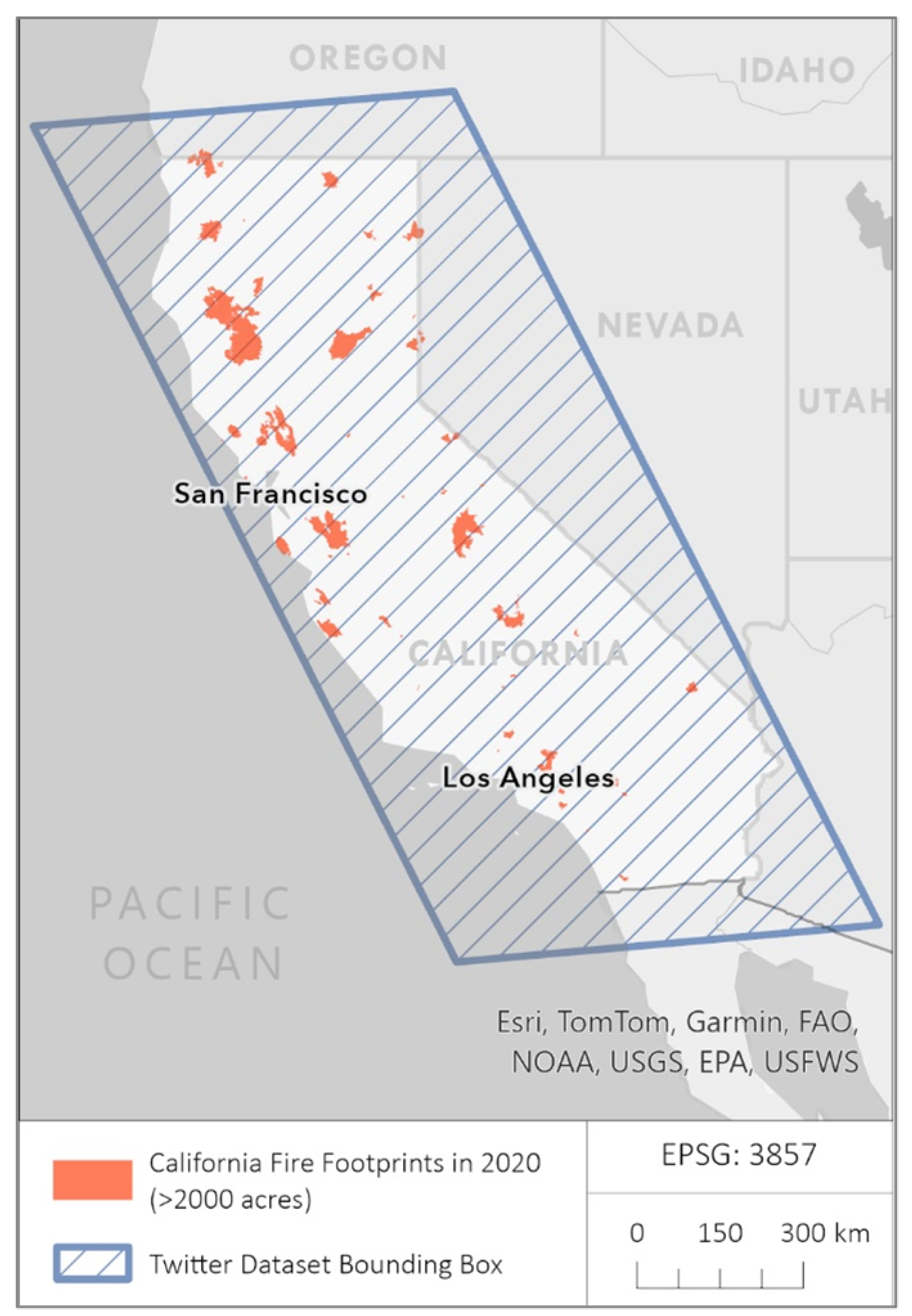

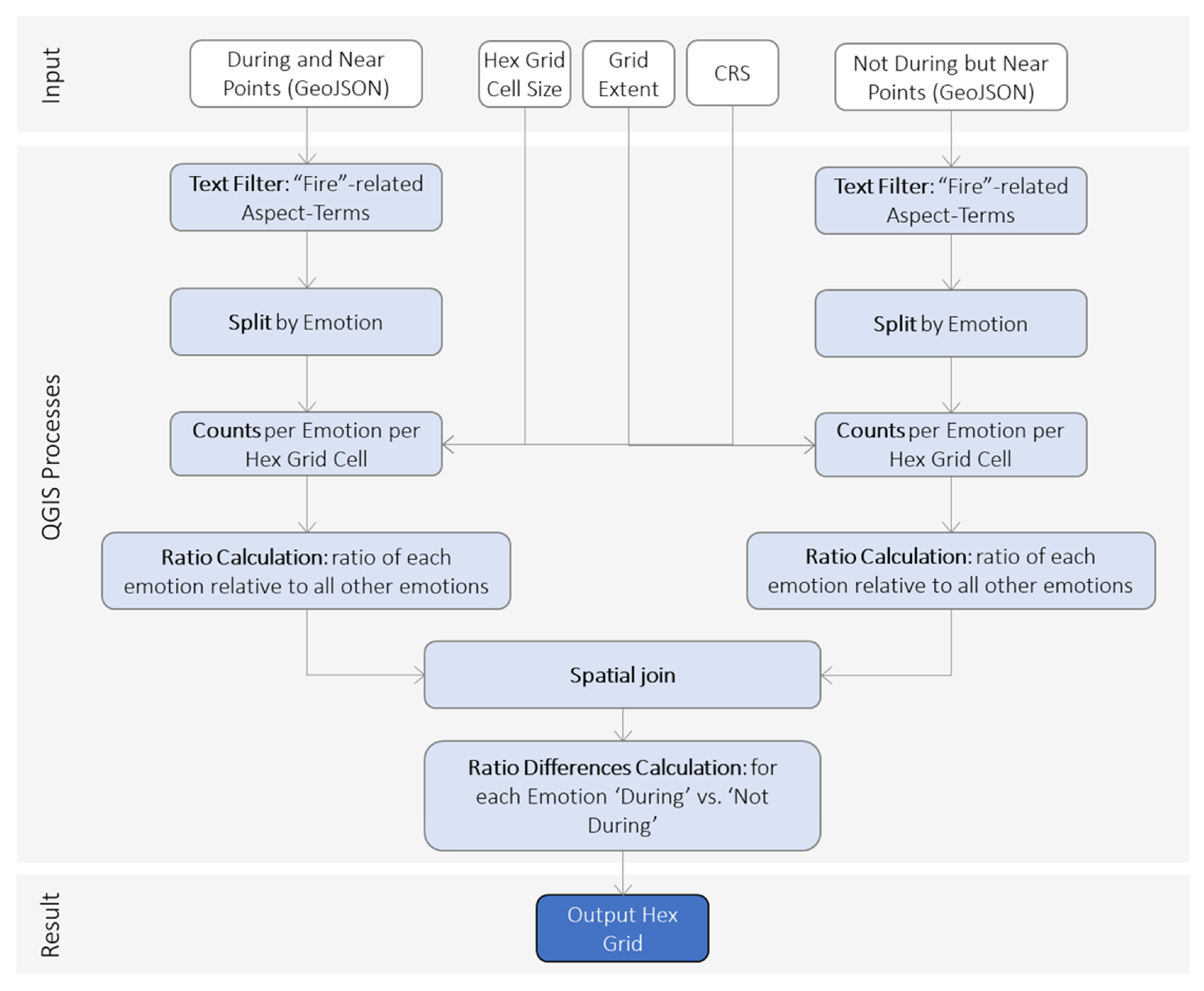

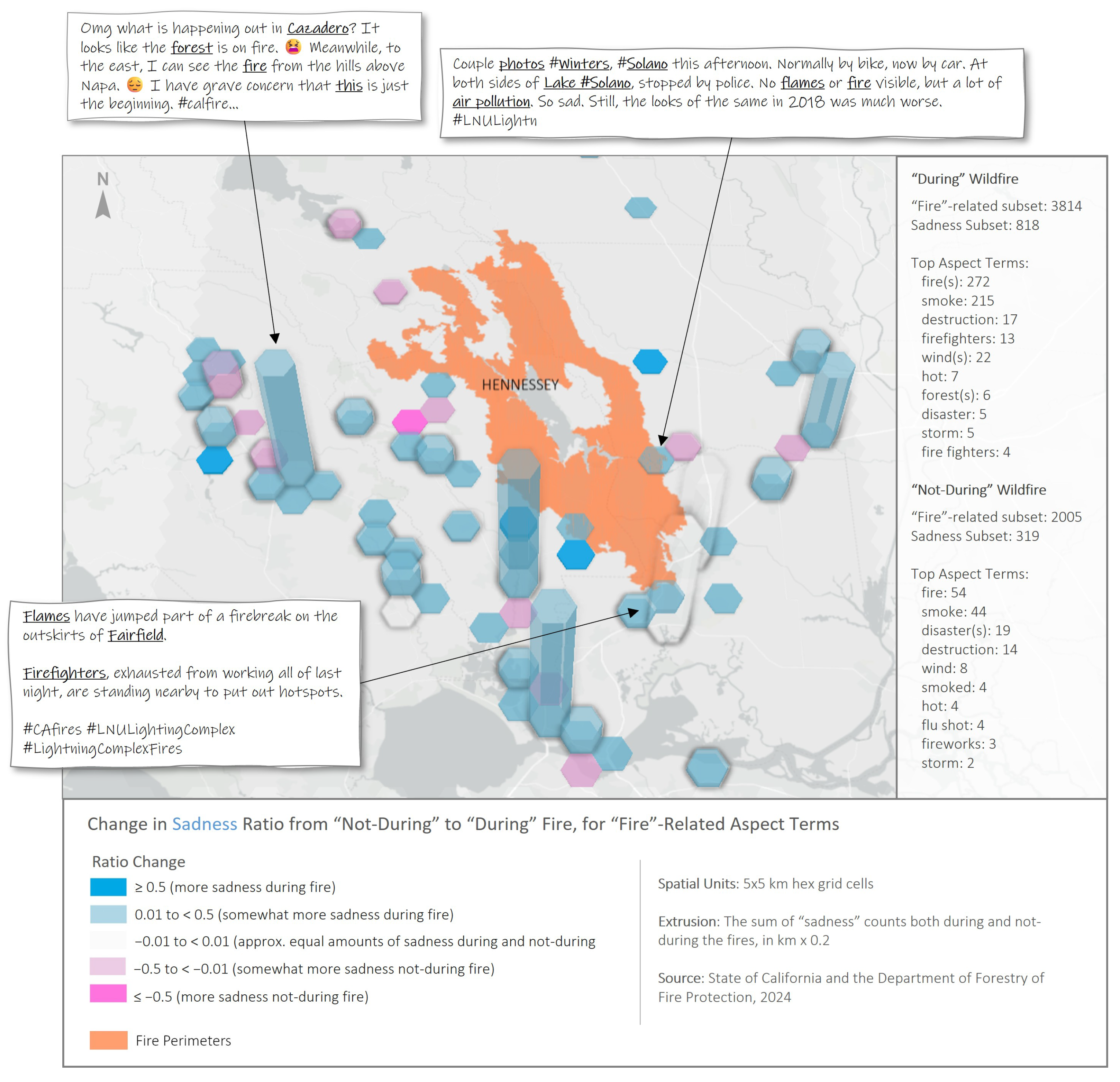
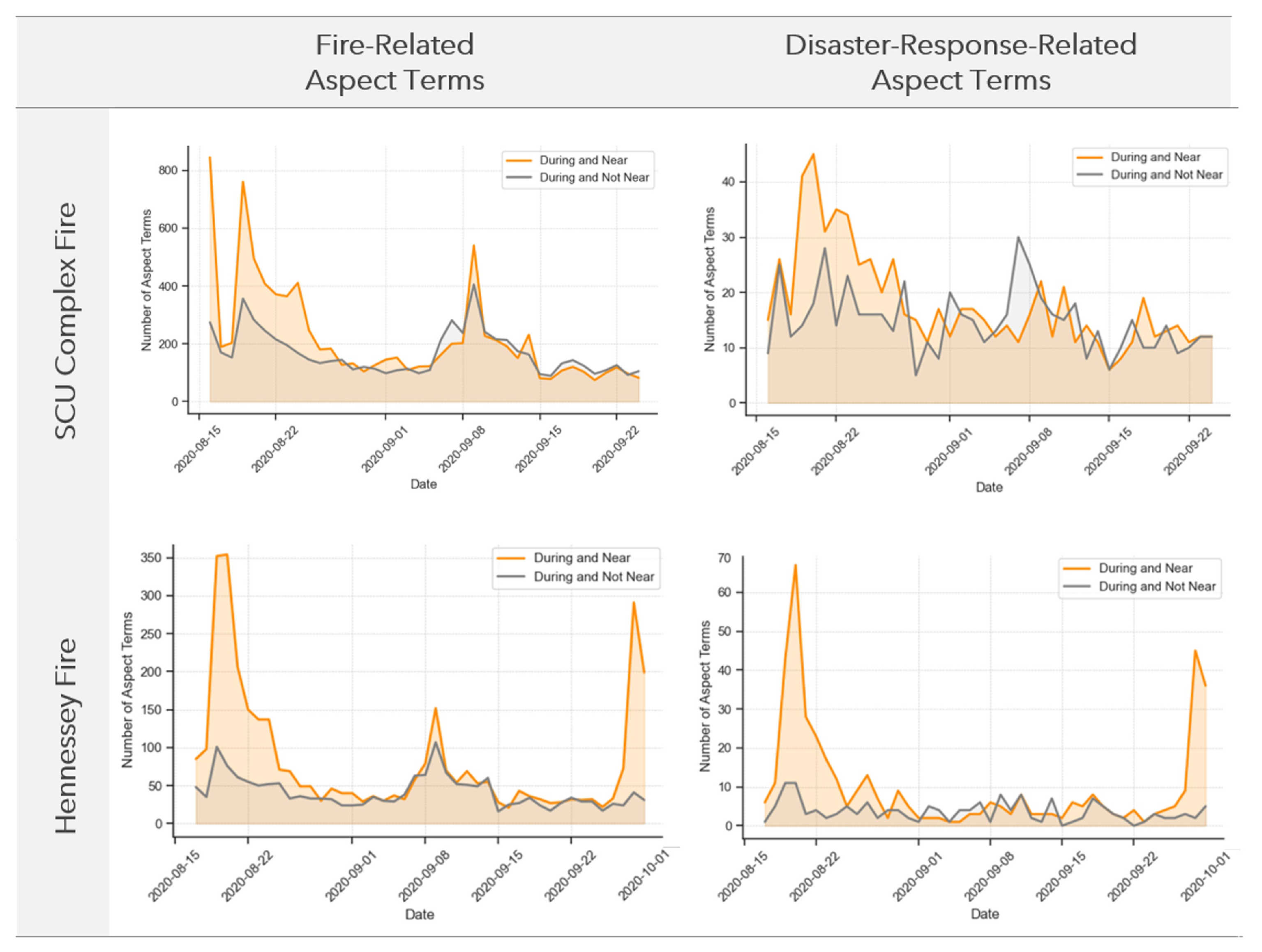

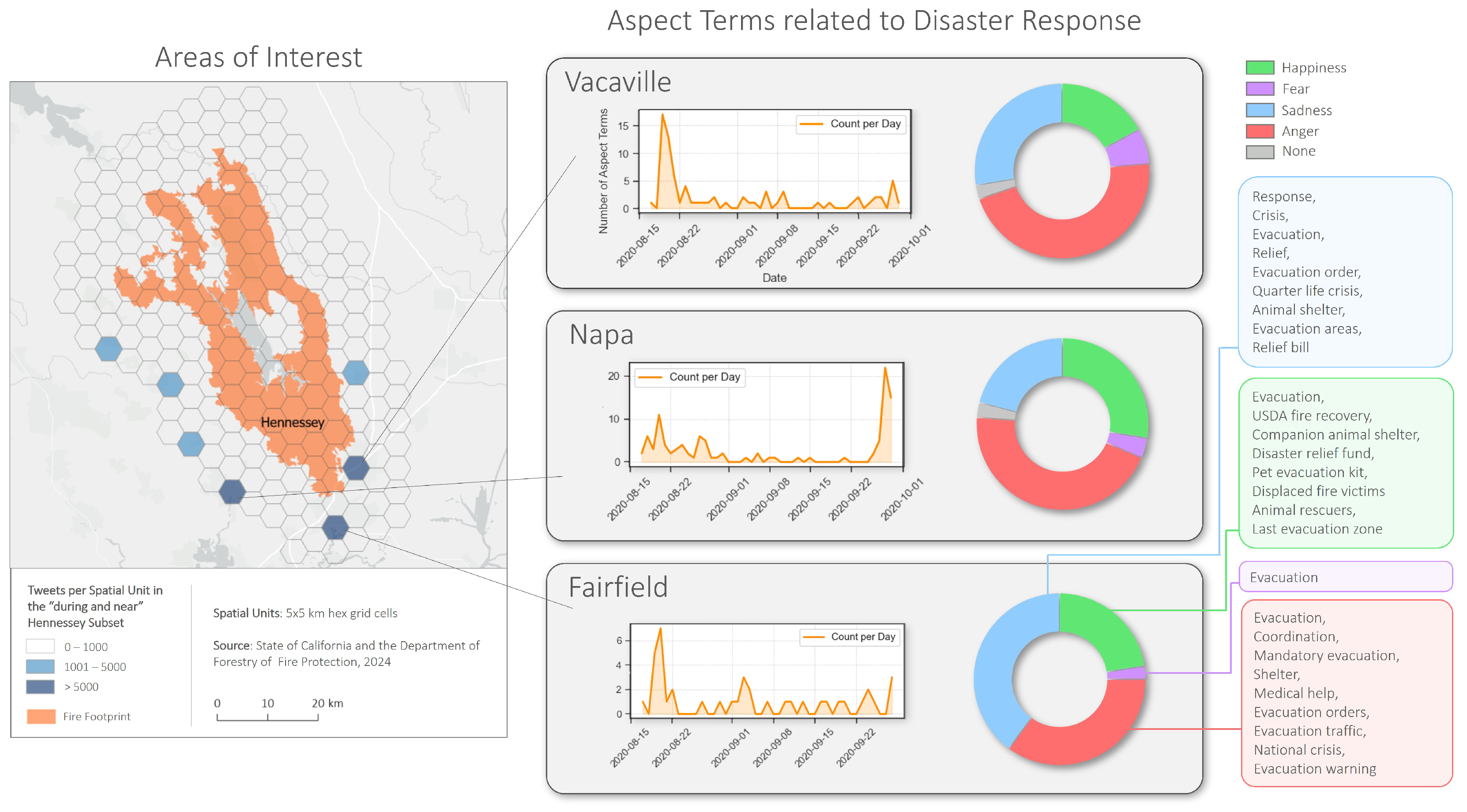
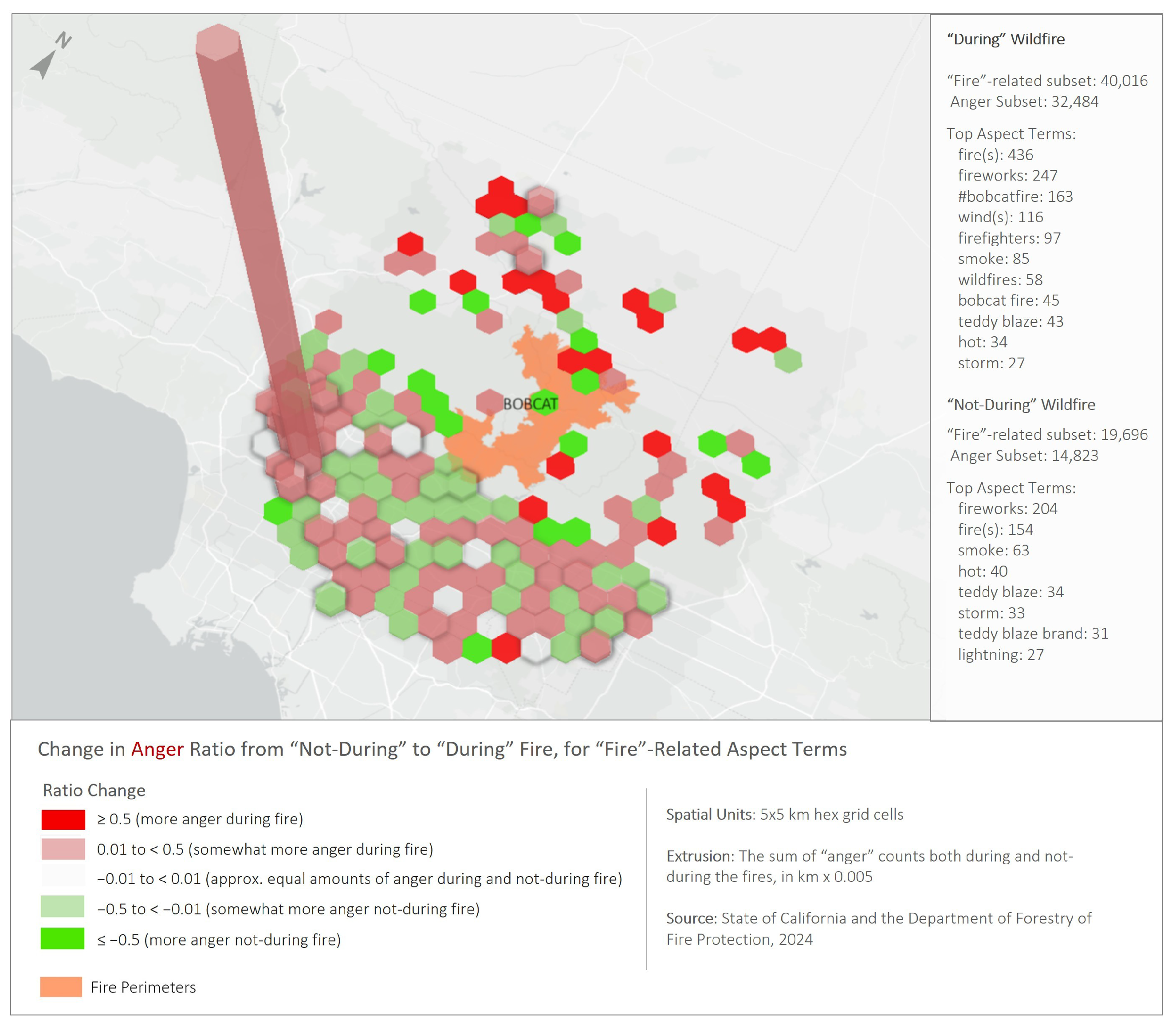
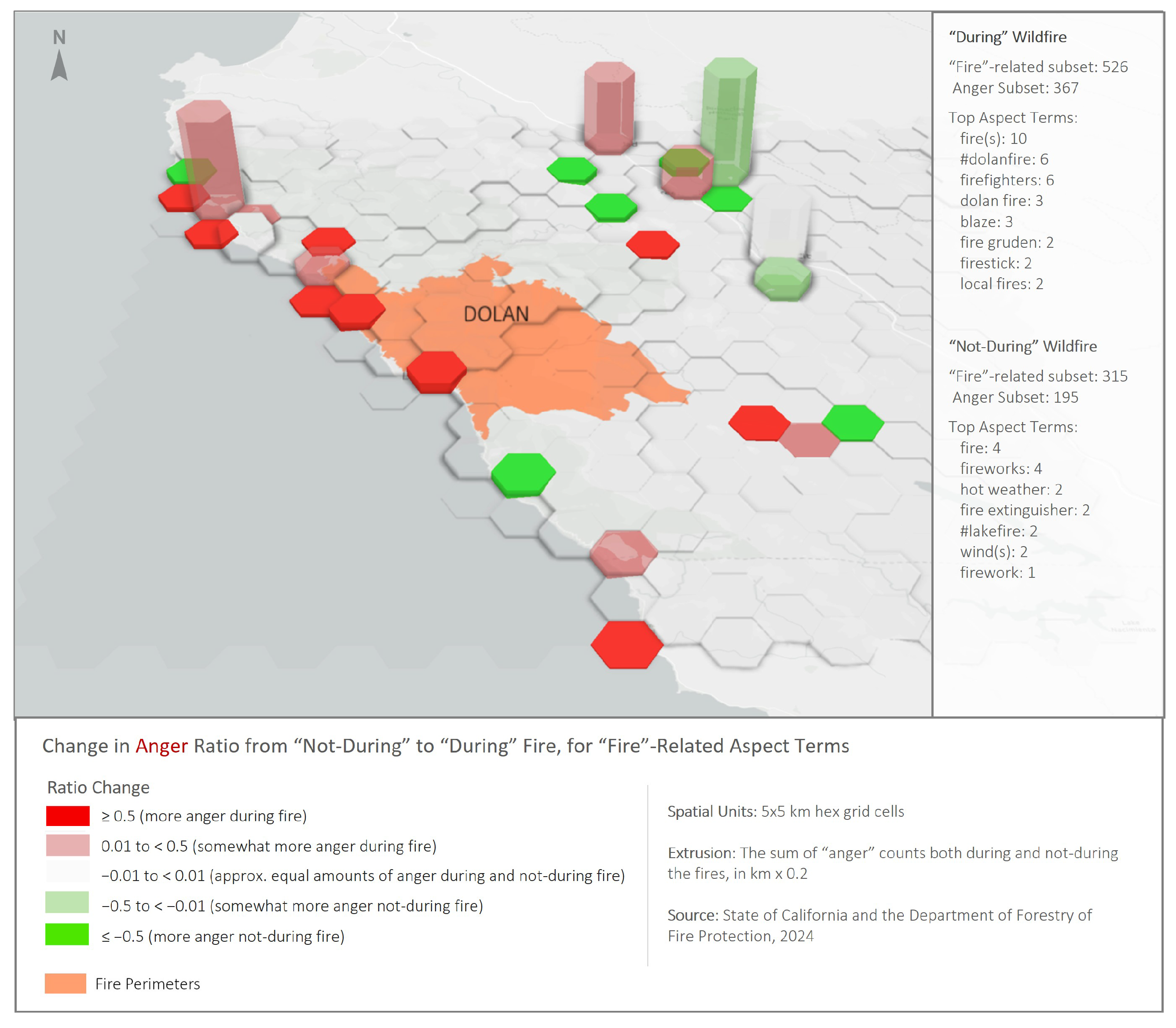
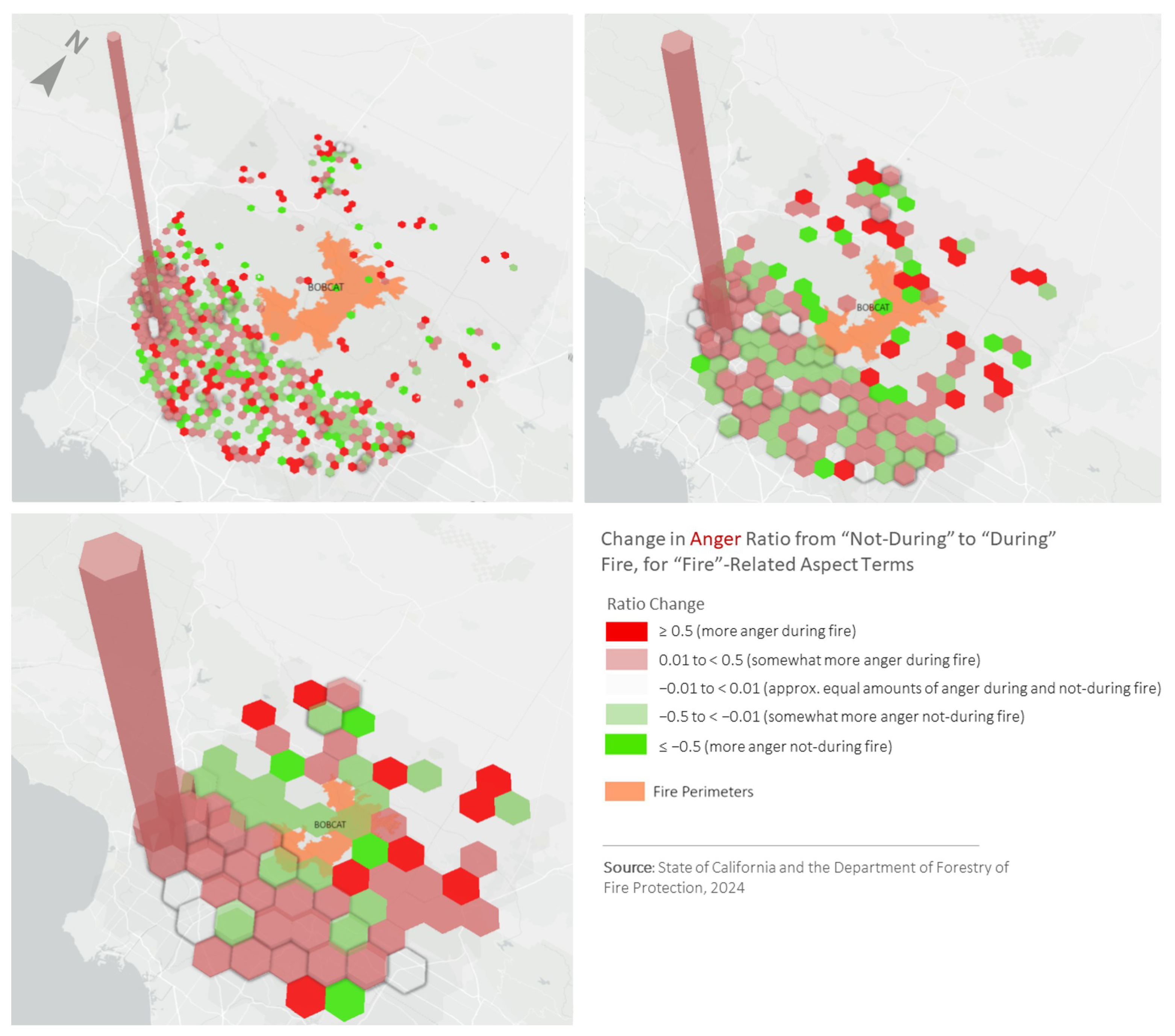
| Subset Name | Geolocation | Timestamp |
|---|---|---|
| During And Near | Within 30 km radius of fire perimeter | During the fire or up to 2 weeks after containment |
| Not During But Near | Within 30 km radius of fire perimeter | Outside of ‘during’ timeframe (not during the fire or up to 2 weeks after) |
| During But Not Near | Outside 30 km radius of fire perimeter | During the fire or up to 2 weeks after containment |
| Wildfire | Sample Size |
|---|---|
| Bobcat | 735,886 |
| SCU Complex | 379,702 |
| Hennessey Complex | 106,685 |
| Dolan | 18,299 |
| Castle | 13,246 |
| North Complex | 8025 |
| Creek | 7596 |
| August Complex | 1733 |
| Red Salmon Complex | 417 |
| Salter | 128 |
Disclaimer/Publisher’s Note: The statements, opinions and data contained in all publications are solely those of the individual author(s) and contributor(s) and not of MDPI and/or the editor(s). MDPI and/or the editor(s) disclaim responsibility for any injury to people or property resulting from any ideas, methods, instructions or products referred to in the content. |
© 2025 by the authors. Published by MDPI on behalf of the International Society for Photogrammetry and Remote Sensing. Licensee MDPI, Basel, Switzerland. This article is an open access article distributed under the terms and conditions of the Creative Commons Attribution (CC BY) license (https://creativecommons.org/licenses/by/4.0/).
Share and Cite
Zorenböhmer, C.; Gandhi, S.; Schmidt, S.; Resch, B. An Aspect-Based Emotion Analysis Approach on Wildfire-Related Geo-Social Media Data—A Case Study of the 2020 California Wildfires. ISPRS Int. J. Geo-Inf. 2025, 14, 301. https://doi.org/10.3390/ijgi14080301
Zorenböhmer C, Gandhi S, Schmidt S, Resch B. An Aspect-Based Emotion Analysis Approach on Wildfire-Related Geo-Social Media Data—A Case Study of the 2020 California Wildfires. ISPRS International Journal of Geo-Information. 2025; 14(8):301. https://doi.org/10.3390/ijgi14080301
Chicago/Turabian StyleZorenböhmer, Christina, Shaily Gandhi, Sebastian Schmidt, and Bernd Resch. 2025. "An Aspect-Based Emotion Analysis Approach on Wildfire-Related Geo-Social Media Data—A Case Study of the 2020 California Wildfires" ISPRS International Journal of Geo-Information 14, no. 8: 301. https://doi.org/10.3390/ijgi14080301
APA StyleZorenböhmer, C., Gandhi, S., Schmidt, S., & Resch, B. (2025). An Aspect-Based Emotion Analysis Approach on Wildfire-Related Geo-Social Media Data—A Case Study of the 2020 California Wildfires. ISPRS International Journal of Geo-Information, 14(8), 301. https://doi.org/10.3390/ijgi14080301








